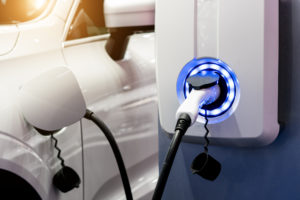Electric vehicles (EVs) are gaining a heap of attention right now. Government initiatives have been popping up in an effort to drive (sorry) public interest in investing in this more eco-friendly transport option.
And though Australia has long been criticised for its particularly slow response to EV technology, there is some growing interest in this space. Most recently, the Morrison government announced a $250 million expanded Future Fuels Fund that it says will focus on “Public electric vehicle charging and hydrogen refuelling infrastructure; Heavy and long-distance vehicle technologies; Commercial fleets and Household smart charging”.
But while additional charging infrastructure is a positive thing, the announcement was met with criticism for its less than enthusiastic push for Aussies to switch to electric.
Prime Minister Morrison said in a statement that, “Australians love their family sedan, farmers rely on their trusted ute and our economy counts on trucks and trains to deliver goods from coast to coast.
“We will not be forcing Australians out of the car they want to drive or penalising those who can least afford it through bans or taxes. Instead, the Strategy will work to drive down the cost of low and zero-emission vehicles, and enhance consumer choice.”
Comparatively, as The Guardian has reported, other nations are looking to ban fossil fuel cars in the next decade.
In any case, if you’re not super familiar with EVs and how they work, we’re here to offer a simple introduction. For this, I chatted with Behyad Jafari, CEO at the EV Council of Australia and Danny Lenartic, Product and Marketing Director at MG Motor Australia for some insight.
Here’s your beginner’s guide to EVs in Australia.
First of all, what is an EV?
The term ‘EV’ stands for electric vehicle and refers to cars that are powered by electricity either completely or in part.
Within the EV umbrella there exist a few different kinds of cars. Often you’ll see this broken down into Battery Electric Vehicles (BEVs) and Plug-in Hybrid Electric Vehicles (PHEVs) but there are more options still.
Fuel Cell Electric Vehicle (FCEV) and Non-plug-in hybrid EVs (HEVs) are also part of the conversation so it’s worth understanding the difference between them all.
For simplicity’s sake, I’ve gone and included the government definitions from the Australian Renewable Energy Agency for you below:
Battery electric vehicles (BEVs): fully-electric, meaning they are solely powered by electricity and do not have a petrol, diesel or LPG engine, fuel tank or exhaust pipe. BEVs are also known as ‘plug-in’ EVs as they use an external electrical charging outlet to charge the battery
Plug-in hybrid electric vehicles (PHEVs): powered by a combination of liquid fuel and electricity. They can be charged with electricity using a plug but also contain an internal combustion engine that uses liquid fuel
Fuel cell electric vehicles (FCEVs): use a fuel cell instead of a battery, or in combination with a battery or supercapacitor, to power their electric motors. FCEVs are typically fuelled by hydrogen and usually provide greater range than BEVs
Non-plug-in hybrid EVs (HEVs): instead of using an external plug to charge the vehicle, the electricity generated by the HEV’s braking system is used to recharge the battery. This is called ‘regenerative braking’ and is also used in BEVs, PHEVs and FCEVs.
The use of electric vehicles is being offered as a means of reducing fossil fuel emissions internationally, but Australia has been especially slow to adopt the tech.
As The Guardian recently reported, cars are the cause of about half of Australia’s transport emissions (and 8 per cent of total emissions) so cutting this source by transitioning over to EVs has the potential to significantly aid Australia’s efforts in reducing carbon emissions.
That same Guardian piece stated that in 2020, 0.7 per cent of new car sales were made up by all-electric cars. The ABC shares that 75 per cent of new car sales by 2030 must be electric for Australia to reach net-zero emissions by 2035.
Put plainly, Lenartic shared that “The major benefit is that EVs generate zero exhaust emissions while being driven and can also be recharged utilising a range of renewable energy sources”.
Are attitudes changing towards EVs in Australia?
According to Jafari, trends are moving towards a more EV-filled future for Aussie car owners.
“In our surveys, more than half of Australians say they’d like their next car to be electric, as long as the right ones [are] available to them. The good news is that’s increasingly true as more companies bring electric vehicle options to our market for sale,” he said.
Lenartic added that “we’re now past the point of ‘early adopters’ for electric and hybrid models and we are seeing these new energy technologies arriving with dealers in greater numbers”.
Until this point, interest in EVs hasn’t translated into sales, but pricing changes and increased accessibility may be able to rectify that.
Can you buy an affordable EV?
If you consider that the ABC reports Teslas priced between $73,000 to $144,000 were one of the more popular EV models in Australia for 2020, it’s easy to see how many people may feel priced out of this world.
Jafari stressed that there is a range of available prices for EVs in the Aussie market (though this recent ABC piece indicates supply is lacking).
“Depending on your requirements, there are many options out there that come at a range of prices. The MG ZS EV is currently the most affordable EV on the market, but there are a whole range of options for people to choose from based on their needs and tastes,” he shared.
On this point, he did also state that while upfront costs may be “more expensive than conventional petrol and diesel vehicles, they [EVs] will become more affordable with time as competition, investment and innovation increases their attractiveness in Australia”.
Lenartic spoke to pricing also, sharing that “Last year, we [MG Motor Australia] re-designed our business plan to make EVs more affordable and available to everyone and this year, we have launched the MG HS Plug-in Hybrid to reinforce that strategy”.
“This has ensured MG offers the most accessible electric (MG ZS EV) and hybrid vehicles (MG HS PHEV) in Australia.”
The MG ZS EV is priced from $44,990, currently. It’s no Tesla cost bracket but it’s still a sizable chunk. If you’d like to take a look at other models available in Australia, the Electric Vehicle’s Council has a round-up here.
As a comparison, the Hyundai IONIQ Electric and Nissan Leaf are listed with starting prices of $54,418 and $53,190 respectively.

Will I have to sacrifice performance?
Aside from pricing, performance and long-distance driving ability are likely to be the second biggest concern for folks considering EVs. On this point, Jafari explained that speed and acceleration rate shouldn’t be a problem and that the driving experience is generally “quiet and smooth”.
Taking a peek at industry reviews can give you a better indication of where we’re at. And while some models are met with little enthusiasm, there are EV models that have received positive wraps.
He added that “Depending on how far you drive, electric cars come with different ranges from 250-600km per charge. For most drivers, most of the time, that’ll mean you’ll never have to think about range. Most of us drive 30 or so kilometres a day, that means getting home and plugging in your car every week or so.”
When it comes to longer distances, he shared that more charging stations are popping up in public spaces, making charging on the go far easier. You can check out this map of charging locations around Australia for more of an idea.
The government website for Infrastructure Australia states that as of 2019, Electric Vehicle Council data suggested that “Australia currently has less than 2,500 public charging stations, of which approximately 350 are fast charging”.
So naturally, an increase in fast-charging stations can only be a positive thing for EV adoption.
The last point of note highlighted by Jafari was the lifespan of electric car batteries. On this he shared that: “Modern electric car batteries can outlast the car itself, going on to have a second life providing power storage to buildings”.
“Most manufacturers are offering industry-standard eight-year battery warranties, with the longer battery warranty demonstrating their confidence in the tech.”
So, I suppose the only question that remains is: are you ready to go electric?
This article has been updated since its original publish date.

Leave a Reply
You must be logged in to post a comment.